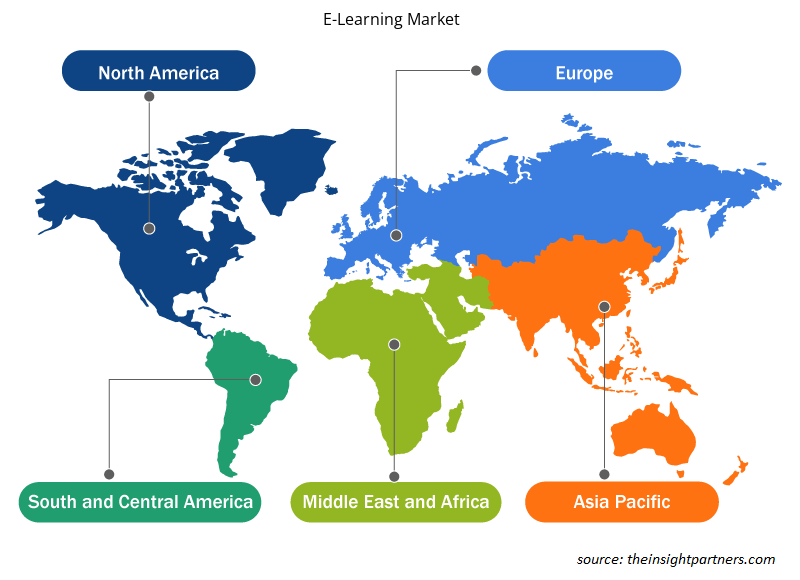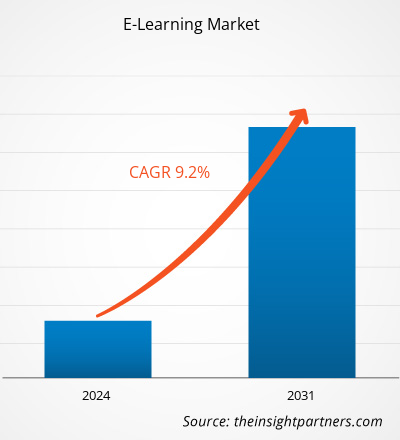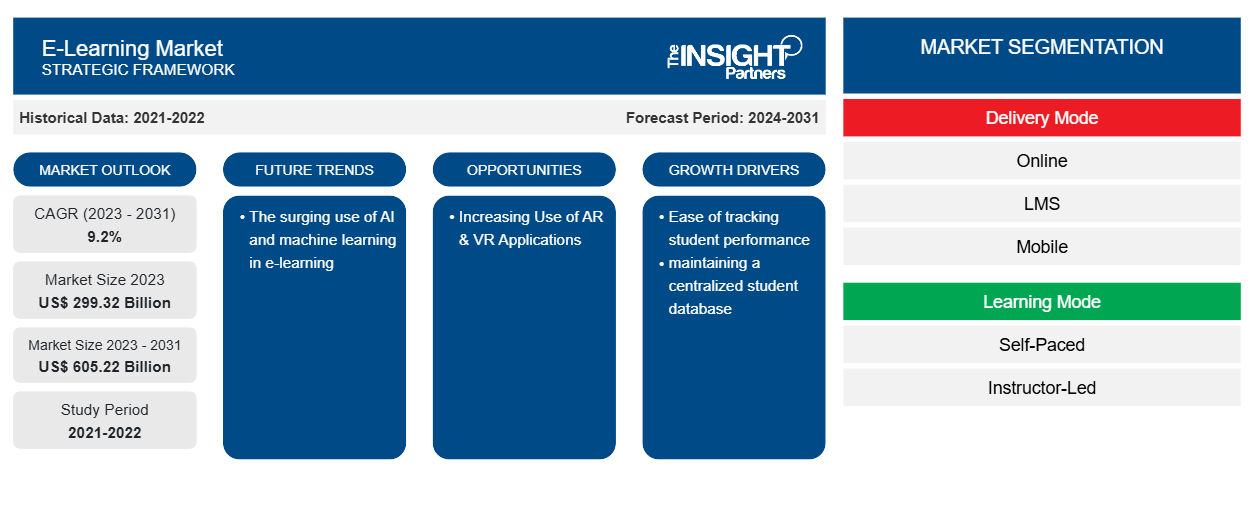ومن المتوقع أن يصل حجم سوق التعلم الإلكتروني إلى 605.22 مليار دولار أمريكي بحلول عام 2031 من 299.32 مليار دولار أمريكي في عام 2023.ومن المتوقع أن يسجل السوق معدل نمو سنوي مركب بنسبة 9.2% خلال الفترة 2023-2031. ومن المرجح أن يظل الاستخدام المتزايد للذكاء الاصطناعي والتعلم الآلي في التعلم الإلكتروني اتجاهًا رئيسيًا في السوق.
تحليل سوق التعلم الإلكتروني
لقد تجاوز التعليم عبر الإنترنت والتعليم القائم على التكنولوجيا التعليم القائم على الفصول الدراسية من حيث التكلفة وإمكانية الوصول والوقت والراحة. يمكن للطلاب تعزيز مهاراتهم من خلال التسجيل في الدورات التي يقدمها خبراء وجامعات من جميع أنحاء العالم. وبصرف النظر عن الطلاب، فإن المهنيين العاملين هم شريحة أخرى مهمة مستهدفة لمنظمات التعلم الرقمي. أصبحت الشهادات عبر الإنترنت شائعة بشكل متزايد في مناخ الشركات التنافسي اليوم. ومن المتوقع ترقية المهارات بشكل مستمر في مختلف الصناعات، بما في ذلك تكنولوجيا المعلومات، وشركات التعهيد الخارجي، وشركات إدارة العمليات الرئيسية، والشركات الناشئة. يأخذ موظفو الشركات بشكل متزايد دورات عبر الإنترنت للبقاء في المقدمة، بينما يطلب معظم المهنيين شهادات لوظائفهم.
نظرة عامة على سوق التعلم الإلكتروني
يشهد سوق التعلم الرقمي توسعًا سريعًا في البلدان النامية، مع انضمام عدد كبير من الشركات الناشئة إلى هذا القطاع. ويعتمد قطاع التعلم الرقمي على عوامل مثل زيادة استخدام الإنترنت، والقيود الزمنية، والعقبات الجغرافية، وانخفاض تكاليف التدريب عبر الإنترنت. وتعزز هذه العوامل التعلم الذاتي وتوسع نطاقه. ومع تزايد الطلب على شهادات الجودة، يتجه المزيد من الأشخاص إلى برامج التعلم عبر الإنترنت.
قم بتخصيص هذا التقرير ليناسب متطلباتك
ستحصل على تخصيص لأي تقرير - مجانًا - بما في ذلك أجزاء من هذا التقرير، أو تحليل على مستوى الدولة، وحزمة بيانات Excel، بالإضافة إلى الاستفادة من العروض والخصومات الرائعة للشركات الناشئة والجامعات
-
احصل على أهم اتجاهات السوق الرئيسية لهذا التقرير.ستتضمن هذه العينة المجانية تحليلاً للبيانات، بدءًا من اتجاهات السوق وحتى التقديرات والتوقعات.
محركات وفرص سوق التعلم الإلكتروني
ارتفاع عدد الأجهزة المتصلة وتزايد انتشار الإنترنت لصالح السوق
يتزايد الطلب على الأجهزة المتصلة، مثل الأجهزة اللوحية وأجهزة الكمبيوتر المحمولة والهواتف الذكية، على مستوى العالم. ويزداد الطلب بشكل أكبر بسبب سيناريوهات التعلم من المنزل والعمل من المنزل. ونظرًا لعدم تمكن الطلاب من حضور المدرسة أو الفصول الدراسية بسبب إجراءات الإغلاق والتباعد الاجتماعي بسبب جائحة كوفيد-19، فقد تم إجراء تعليمهم عبر الإنترنت، مما أدى في النهاية إلى زيادة الطلب على الهواتف الذكية وأجهزة الكمبيوتر المحمولة. وعلاوة على ذلك، أدى تطوير خدمات الاتصالات على مستوى العالم إلى زيادة انتشار الإنترنت، حتى في المناطق النائية من العالم، وهذا يكمل سوق التعلم الإلكتروني العالمي.
زيادة استخدام تطبيقات الواقع المعزز والواقع الافتراضي
في السنوات الأخيرة، اكتسبت تقنيات الواقع المعزز والواقع الافتراضي شعبية كبيرة في قطاعي التعليم والتدريب باعتبارها طرقًا ممتازة لتحسين تجربة التعلم. يمكن أن توفر تقنيات الواقع المعزز والواقع الافتراضي التعلم عن بعد والمرن، مما يسمح للطلاب بالوصول إلى مواد التدريب والمحاكاة من أي مكان في العالم. يمكن أن يكون هذا مفيدًا بشكل خاص عندما لا يتمكن الطلاب من حضور جلسات التدريب الشخصية.
تحليل تجزئة تقرير سوق التعلم الإلكتروني
إن القطاعات الرئيسية التي ساهمت في استخلاص تحليل سوق التعلم الإلكتروني هي طريقة التسليم، وطريقة التعلم، والمستخدم النهائي.
- بناءً على طريقة التسليم، ينقسم سوق التعلم الإلكتروني إلى التعلم عبر الإنترنت، ونظام إدارة التعلم، والتعلم عبر الهاتف المحمول، وغيرها. احتل قطاع التعلم عبر الإنترنت حصة سوقية أكبر في عام 2023.
- من خلال وضع التعلم، يتم تقسيم السوق إلى التعلم الذاتي والتعلم بقيادة مدرب.
- بحسب المستخدم النهائي، يتم تقسيم السوق إلى أكاديمي وشركاتي. وتعتبر مؤسسات التعليم من الروضة حتى الصف الثاني عشر وما فوقها من القطاعات الفرعية البارزة في شريحة المستخدم النهائي.
تحليل حصة سوق التعلم الإلكتروني حسب المنطقة الجغرافية
ينقسم النطاق الجغرافي لتقرير سوق التعلم الإلكتروني بشكل أساسي إلى خمس مناطق: أمريكا الشمالية، ومنطقة آسيا والمحيط الهادئ، وأوروبا، والشرق الأوسط وأفريقيا، وأمريكا الجنوبية والوسطى.
سيطرت أمريكا الشمالية على حصة سوق التعلم الإلكتروني في عام 2023. ووفقًا لتقرير HurixDigital 2023، تعد الولايات المتحدة واحدة من الدول الرائدة في العالم من حيث التنفيذ الناجح للتعليم الإلكتروني في التعليم.
رؤى إقليمية حول سوق التعلم الإلكتروني
لقد قام المحللون في Insight Partners بشرح الاتجاهات والعوامل الإقليمية المؤثرة على سوق التعلم الإلكتروني طوال فترة التوقعات بشكل شامل. يناقش هذا القسم أيضًا قطاعات سوق التعلم الإلكتروني والجغرافيا في جميع أنحاء أمريكا الشمالية وأوروبا ومنطقة آسيا والمحيط الهادئ والشرق الأوسط وأفريقيا وأمريكا الجنوبية والوسطى.

- احصل على البيانات الإقليمية المحددة لسوق التعلم الإلكتروني
نطاق تقرير سوق التعلم الإلكتروني
| سمة التقرير | تفاصيل |
|---|---|
| حجم السوق في عام 2023 | 299.32 مليار دولار أمريكي |
| حجم السوق بحلول عام 2031 | 605.22 مليار دولار أمريكي |
| معدل النمو السنوي المركب العالمي (2023 - 2031) | 9.2% |
| البيانات التاريخية | 2021-2022 |
| فترة التنبؤ | 2024-2031 |
| القطاعات المغطاة |
حسب طريقة التسليم
|
| المناطق والدول المغطاة |
أمريكا الشمالية
|
| قادة السوق وملفات تعريف الشركات الرئيسية |
|
كثافة اللاعبين في سوق التعلم الإلكتروني: فهم تأثيرها على ديناميكيات الأعمال
يشهد سوق التعلم الإلكتروني نموًا سريعًا، مدفوعًا بالطلب المتزايد من جانب المستخدم النهائي بسبب عوامل مثل تفضيلات المستهلكين المتطورة والتقدم التكنولوجي والوعي المتزايد بفوائد المنتج. ومع ارتفاع الطلب، تعمل الشركات على توسيع عروضها والابتكار لتلبية احتياجات المستهلكين والاستفادة من الاتجاهات الناشئة، مما يؤدي إلى زيادة نمو السوق.
تشير كثافة اللاعبين في السوق إلى توزيع الشركات أو المؤسسات العاملة في سوق أو صناعة معينة. وهي تشير إلى عدد المنافسين (اللاعبين في السوق) الموجودين في مساحة سوق معينة نسبة إلى حجمها أو قيمتها السوقية الإجمالية.
الشركات الرئيسية العاملة في سوق التعلم الإلكتروني هي:
- كورسيرا
- إدكس
- التعلم عبر لينكدإن
- مهارات المشاركة
- سكيلسوفت
- يوداسيتي
إخلاء المسؤولية : الشركات المذكورة أعلاه ليست مرتبة بأي ترتيب معين.

- احصل على نظرة عامة على أهم اللاعبين الرئيسيين في سوق التعلم الإلكتروني
أخبار سوق التعلم الإلكتروني والتطورات الأخيرة
يتم تقييم سوق التعلم الإلكتروني من خلال جمع البيانات النوعية والكمية بعد البحث الأولي والثانوي، والتي تتضمن منشورات الشركات المهمة وبيانات الجمعيات وقواعد البيانات. فيما يلي بعض التطورات في سوق التعلم الإلكتروني:
- أعلنت جامعة ويليام وودز (WWU) اليوم رسميًا عن اتفاقية مع Coursera، وهي منصة تعليمية عالمية عبر الإنترنت، والتي ستوسع بشكل كبير الوصول إلى المحتوى الرقمي ذي الصلة بمكان العمل اليوم، وتقدم تدريبًا على المهارات وشهادات معترف بها في الصناعة للمهارات الوظيفية المطلوبة لطلاب WWU والموظفين والخريجين وشركاء الجامعة. ستسمح الشراكة الجديدة لجامعة ويليام وودز بالتعلم من أكثر من 325 جامعة وشركة رائدة على Coursera، مع دورات تدريبية عبر الإنترنت وشهادات في مجموعة متنوعة من التخصصات ودمجها في مناهج الجامعة، مما يعزز بشكل أكبر من الخبرة الأكاديمية وقابلية تسويق كل طالب في WWU للتوظيف. (المصدر: جامعة ويليام وودز، بيان صحفي، فبراير 2024)
- أعلنت edX و Degreed عن شراكة استراتيجية موسعة لتزويد المؤسسات بمحتوى تعليمي متميز وحلول منصة تعزز التعلم القائم على المهارات. الآن، أصبح edX For Business - وهو حل محتوى الأفضل في فئته للمؤسسات التي تتطلع إلى تعزيز برامج التعلم والتطوير الأكثر تأثيرًا - متاحًا للمؤسسات وموظفيها مباشرة داخل منصة Degreed، مما يعكس جهدًا متضافرًا لإعادة تعريف كيفية تدريب الشركات وصقل مهاراتها والاحتفاظ بالمواهب في كل مستوى من مستويات قوتها العاملة. (المصدر: edX، بيان صحفي، ديسمبر 2023)
تغطية تقرير سوق التعلم الإلكتروني والمنتجات النهائية
يوفر تقرير "حجم سوق التعلم الإلكتروني والتوقعات (2021-2031)" تحليلاً مفصلاً للسوق يغطي المجالات التالية:
- حجم سوق التعلم الإلكتروني وتوقعاته على المستويات العالمية والإقليمية والوطنية لجميع قطاعات السوق الرئيسية التي يغطيها النطاق
- اتجاهات سوق التعلم الإلكتروني بالإضافة إلى ديناميكيات السوق مثل المحركات والقيود والفرص الرئيسية
- تحليل مفصل لقوى PEST/Porter الخمس وSWOT
- تحليل سوق التعلم الإلكتروني الذي يغطي اتجاهات السوق الرئيسية والإطار العالمي والإقليمي والجهات الفاعلة الرئيسية واللوائح والتطورات الأخيرة في السوق
- تحليل المشهد الصناعي والمنافسة الذي يغطي تركيز السوق، وتحليل الخريطة الحرارية، واللاعبين البارزين، والتطورات الأخيرة لسوق التعلم الإلكتروني
- ملفات تعريف الشركة التفصيلية
- التحليل التاريخي (سنتان)، سنة الأساس، التوقعات (7 سنوات) مع معدل النمو السنوي المركب
- تحليل PEST و SWOT
- حجم السوق والقيمة / الحجم - عالمي، إقليمي، بلد
- الصناعة والمنافسة
- مجموعة بيانات إكسل
التقارير الحديثة
شهادات العملاء
سبب الشراء
- اتخاذ قرارات مدروسة
- فهم ديناميكيات السوق
- تحليل المنافسة
- رؤى العملاء
- توقعات السوق
- تخفيف المخاطر
- التخطيط الاستراتيجي
- مبررات الاستثمار
- تحديد الأسواق الناشئة
- تحسين استراتيجيات التسويق
- تعزيز الكفاءة التشغيلية
- مواكبة التوجهات التنظيمية























 احصل على عينة مجانية ل - سوق التعلم الإلكتروني
احصل على عينة مجانية ل - سوق التعلم الإلكتروني